|
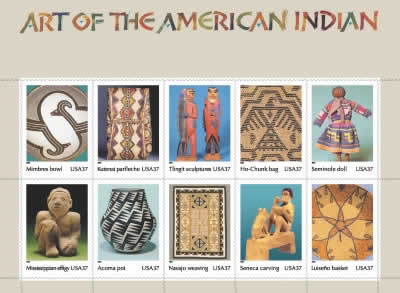 WASHINGTON,
July 27 /PRNewswire/ -- Captivating expressions of Native American
art will be commemorated August 21 in Santa Fe, NM, when the U.S.
Postal Service issues ten, 37-cent Art of the American Indian commemorative
postage stamps and a booklet of twenty, 23-cent stamped postal cards
depicting the beauty, richness and diversity of talent by artists
from several Native American tribes. WASHINGTON,
July 27 /PRNewswire/ -- Captivating expressions of Native American
art will be commemorated August 21 in Santa Fe, NM, when the U.S.
Postal Service issues ten, 37-cent Art of the American Indian commemorative
postage stamps and a booklet of twenty, 23-cent stamped postal cards
depicting the beauty, richness and diversity of talent by artists
from several Native American tribes.
The
first-day-of-issue stamp dedication ceremony will take place at
11 a.m. (Mountain Time) on the Plaza Stage during the Santa Fe Indian
Market. This annual event, sponsored by the Southwestern Association
for Indian Arts (SWAIA), draws some 1,200 Indian artists who market
their creations to 100,000 visitors (http://swaia.org/).
"These
stamps represent a small sampling of the diverse ways that Native
Americans created objects used in their everyday lives that were
also extraordinary expressions of beauty," said Chief Marketing
Officer and Senior Vice President Anita Bizzotto, who is scheduled
to dedicate the stamps.
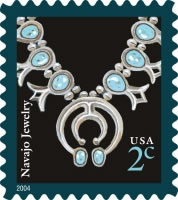 Joining
Bizzotto in dedicating the stamps will be SWAIA Executive Director
Jai Lakshman. "The Santa Fe Indian Market is greatly honored
to provide the host-setting for the release of these stamps,"
he said. "The pieces featured remind all Americans of the extraordinary
vision and talent of the American Indian artists who have paved
the way for Native artists who continue to share their gifts of
creativity today." Joining
Bizzotto in dedicating the stamps will be SWAIA Executive Director
Jai Lakshman. "The Santa Fe Indian Market is greatly honored
to provide the host-setting for the release of these stamps,"
he said. "The pieces featured remind all Americans of the extraordinary
vision and talent of the American Indian artists who have paved
the way for Native artists who continue to share their gifts of
creativity today."
Creative
expression continues to flourish among American Indian artists today.
Some still create traditional forms; others are expanding their
artistic endeavors in new directions in the fields of painting,
sculpture, photography, printmaking, video and performance art.
The
pane of ten jumbo, self-adhesive stamps features photographs of
ten American Indian artifacts dating from around the 11th century
A.D. to circa 1969. John Stevens, a calligrapher in Winston-Salem,
NC, designed and created the lettering in the title. Descriptive
text on the back of the stamps includes an overview and specific
information about each of the ten objects. Many of these objects
continue to be created by Native American artists today.
Santa
Fe, as host city for this first-day-of-issue dedication ceremony,
will be the only city in the nation where the Art of the American
Indian stamps and stamped postal cards are available Saturday, August
21. They will be available at Post Offices and Philatelic Centers
nationwide beginning Monday, August 23.
Executed
in a variety of media, these artifacts illustrate the talent, ingenuity,
and artistic skills of America's first peoples. Descriptions of
the stamps:
| A
Mimbres bowl from the Maxwell Museum of Anthropology, The University
of New Mexico, Albuquerque. The Mimbres people of southwestern
New Mexico produced a unique style of black-on-white pottery
featuring representations of wildlife, humans, or mythic beings
combined with geometric motifs. Most bowls of the Classic Mimbres
period (circa A.D. 1000-1150) probably served as eating vessels.
This striking example depicts two stylized bighorn sheep, animals
that were once common in the Mimbres area. |
 |
| A
Kutenai parfleche from the American Museum of Natural History
in New York City. Containers of folded or sewn rawhide, known
as parfleches, were traditionally used by Plains and Plateau
tribal groups to store and transport food and material possessions.
These utilitarian objects were painted with colorful and distinctive
geometric patterns that had both aesthetic appeal and spiritual
significance. This Kutenai parfleche was collected in 1900,
probably in Idaho. |
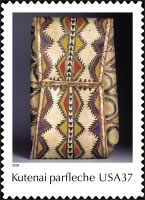 |
| Two
Tlingit sculptures from the Phoebe Apperson Hearst Museum of
Anthropology, University of California, Berkeley. Wood sculpture
was a fundamental form of artistic expression among the men
of the Northwest Coast tribes, and objects carved and painted
in their distinctive style were eagerly sought by tourists and
collectors. These two Tlingit sculptures, dated circa 1890,
likely illustrate the story of Salmon Boy, a youth who lived
for a time with the Salmon People in their supernatural realm
beneath the sea. |
 |
| A
detail from a Ho-Chunk (Winnebago) bag, from the Cranbrook Institute
of Science, Bloomfield Hills, Michigan. Using ingenious twining
techniques, women of the Great Lakes and Central Plains tribes
wove beautiful storage bags of bison hair, plant fibers, and
wool yarn, often incorporating stylized depictions of mythological
beings into their designs. The thunderbird, which embodies the
sky realm, was a favorite motif; this one is a detail from an
1840-1860 Ho-Chunk (Winnebago) bag collected in Nebraska. |
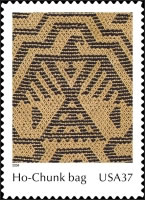 |
| A
Miccosukee-Seminole doll from the National Museum of the American
Indian, Washington, D.C. During the early decades of the 20th
century, Miccosukee-Seminole women in Florida developed a unique
style of patchwork clothing. They used hand-operated sewing
machines to piece together brightly colored cotton shirts and
dresses, and they outfitted dolls made for the tourist trade
in miniature versions of these traditional garments. This male
doll, made circa 1935, wears a man's "foksikco.bi,"
or big shirt. |
 |
| A
Mississippian effigy from the Frank H. McClung Museum, The University
of Tennessee, Knoxville. This sandstone male effigy is an outstanding
example of the art of the late Mississippian culture (A.D. 1300-1550)
in Tennessee. A strikingly naturalistic portrait, the statue
provides a valuable glimpse into a complex prehistoric society.
It was found with a female figurine that was carved in less
detail; together they may represent the ancestors of a founding
lineage. |
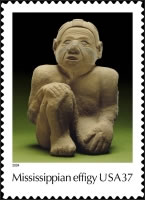 |
| An
Acoma pot made by Lucy Martin Lewis, from the National Museum
of the American Indian, Washington, D.C. Acoma Pueblo in New
Mexico is known for exceptionally thin-walled pottery decorated
with complex geometric designs carefully painted on a white
slip background. Master potter Lucy Martin Lewis (circa 1895
-1992) helped revive the black- on-white style by adapting 800-year-old
Puebloan pottery designs to modern Acoma ceramics. The lightning
pattern on this jar, which she made about 1969, derives from
ancestral traditions. |
 |
| A
Navajo weaving by Daisy Taugelchee, from the Denver Art Museum,
Denver, Colorado. Weaving is the art form for which the Navajo
are best known, and the finely woven textiles from the Two Grey
Hills region in New Mexico -- characterized by geometric designs
executed in natural shades of hand-spun wool yarns with wide
or multiple borders -- are highly esteemed. Daisy Taugelchee
(1911-1990), who set unprecedented standards of fine spinning
and weaving, made this stellar tapestry in the late 1940s. |
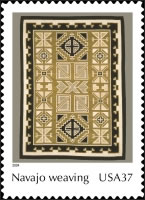 |
| A
detail of a Seneca ladle from the New York State Museum, Albany,
New York, on loan to the Akwesasne Museum, Hogansburg, New York.
Among the Iroquois, carving was traditionally men's work, and
they were adept at transforming wooden utensils into works of
art -- a skill particularly evident in the diverse human and
animal effigies that adorn the handles of ladles. This elaborately
carved handle finial, depicting a dog watching a human eating,
ornaments a mid-19th-century Seneca ladle from the Tonawanda
Reservation in New York. |
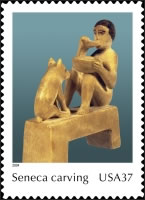 |
| A
Luiseno basket from the Riverside Municipal Museum, Riverside,
California. Renowned for the exquisite beauty and technical
excellence of their basketwork, California Indians -- who used
basketry items for every conceivable utilitarian, social, and
ritual purpose -- elevated a practical craft into fine art.
This superb Luiseno coiled basket, made of split sumac and natural
and black-dyed juncus rush on a grass foundation, probably dates
to the 1890s. |
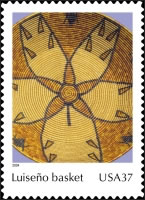 |
How
to Order First-Day-of-Issue Postmark
Customers
have 30 days to obtain the first-day-of-issue postmark by mail.
They may purchase new stamps at their local Post Office, by telephone
at 1-800-STAMP-24, and at the Postal Store Web site at http://www.usps.com/shop.
They should affix the stamps to envelopes of their choice, address
the envelopes (to themselves or others), and place them in a larger
envelope addressed to:
ART OF THE AMERICAN INDIAN COMMEMORATIVE STAMPS
POSTMASTER
120 S Federal PLACE
SANTA FE NM 87501-9998
After
applying the first-day-of-issue postmark, the Postal Service will
return the envelopes through the mail. There is no charge for the
postmark. All orders must be postmarked by September 20, 2004.
|


 WASHINGTON,
July 27 /PRNewswire/ -- Captivating expressions of Native American
art will be commemorated August 21 in Santa Fe, NM, when the U.S.
Postal Service issues ten, 37-cent Art of the American Indian commemorative
postage stamps and a booklet of twenty, 23-cent stamped postal cards
depicting the beauty, richness and diversity of talent by artists
from several Native American tribes.
WASHINGTON,
July 27 /PRNewswire/ -- Captivating expressions of Native American
art will be commemorated August 21 in Santa Fe, NM, when the U.S.
Postal Service issues ten, 37-cent Art of the American Indian commemorative
postage stamps and a booklet of twenty, 23-cent stamped postal cards
depicting the beauty, richness and diversity of talent by artists
from several Native American tribes.  Joining
Bizzotto in dedicating the stamps will be SWAIA Executive Director
Jai Lakshman. "The Santa Fe Indian Market is greatly honored
to provide the host-setting for the release of these stamps,"
he said. "The pieces featured remind all Americans of the extraordinary
vision and talent of the American Indian artists who have paved
the way for Native artists who continue to share their gifts of
creativity today."
Joining
Bizzotto in dedicating the stamps will be SWAIA Executive Director
Jai Lakshman. "The Santa Fe Indian Market is greatly honored
to provide the host-setting for the release of these stamps,"
he said. "The pieces featured remind all Americans of the extraordinary
vision and talent of the American Indian artists who have paved
the way for Native artists who continue to share their gifts of
creativity today."








